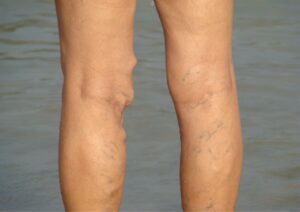
What is a Vein Finder?
A vein finder is a medical device designed to assist healthcare professionals in locating veins beneath the skin. These devices are especially useful for patients with difficult-to-find veins, such as those with dark skin, obesity, or dehydration. By making veins more visible, vein finders improve the accuracy and ease of procedures like blood draws, IV insertions, and other medical interventions.
Medical professionals, including nurses, phlebotomists, anaesthesiologists, paramedics, and plastic surgeons, benefit from accurate vein projection, improved success rates, and enhanced patient safety when using vein finder devices. The use of vein finders has also led to improved patient satisfaction due to reduced pain, decreased procedure time, and an overall better experience.
How Does a Vein Finder Work?
Vein finders use various technologies to detect and highlight veins under the skin. The most common methods include:
Infrared Light: Infrared light is absorbed differently by oxygenated blood and surrounding tissue. This contrast allows the device to create an image of the veins.
Ultrasound: Some vein finders use ultrasound technology to create images of veins. This method is highly accurate but typically more expensive and complex.
Transillumination: A bright light is shined through the skin, illuminating veins as dark lines against the illuminated tissue.
Laser Vein Finder: This innovative medical technology utilizes high-frequency light to provide a projected image of the underlying vascular structure on the skin’s surface.
Vein Illuminator: This device projects the patient’s venous system onto the skin, aiding in injections, blood draws, and cosmetic procedures. It improves venipuncture success rates and enhances vein treatment by using adjustable wavelengths of near-infrared light. Removing body hair at the injection site is important for effective operation.
Do Vein Finders Work?
Yes, vein finders are effective tools for locating veins. They are widely used in medical settings to improve the success rate of venipuncture and other procedures. They can significantly reduce the number of attempts needed to access a vein, thus improving patient comfort and reducing complications. Vein visualization technology further enhances these benefits by providing clear images of veins, which aids in first-attempt success, time and cost savings, and enhanced patient safety.
Is There a Vein Finder App?
Yes, there are vein finder apps available for smartphones. These apps use the camera and flashlight to enhance vein visibility. While not as powerful as dedicated devices, they can be useful in a pinch or for personal use.
Is There a Vein Finder App for Android?
Yes, several vein finder apps are available for Android devices. These apps use the phone’s camera and light to help locate veins. Examples include “VeinSeek Pro” and “VeinScanner.”
How long does vein visualization take?
Vascular mapping is a procedure used to visualise and assess the blood vessels, often prior to surgery or treatment of vascular conditions. The duration of a vascular mapping procedure can vary depending on several factors, including the specific method used, the area of the body being examined, and the complexity of the patient’s vascular system. Here’s a general overview of the time required for different types of vascular mapping:
Are Vein Finders Worth It?
For healthcare professionals, vein finders are definitely worth the investment. They improve the success rate of vein access procedures, reduce patient discomfort, and save time. Improved patient satisfaction is also reported due to reduced pain, decreased procedure time, and an overall better experience. For personal use, they can be helpful but might not be necessary unless you have specific medical conditions.
How to Use a Vein Finder
Using a vein finder typically involves the following steps:
Prepare the Device: Ensure the vein finder is charged or has fresh batteries.
Position the Device: Place the device over the area where you need to locate a vein.
Activate the Device: Turn on the vein finder and adjust settings if necessary.
Identify the Vein: Move the device slowly over the skin until the veins are visible on the screen or illuminated under the skin. The device helps to identify veins with unprecedented clarity, verifying their patency, avoiding valves and bifurcations, and enhancing venipuncture success rates. It can also identify veins that are invisible to the naked eye but too shallow for ultrasound detection.
Mark the Vein: Once a suitable vein is found, mark the location if needed for further procedures.
How to Make a Vein Finder at Home
Creating a vein finder at home is not recommended due to the precision required in medical devices. However, for educational purposes, you could simulate a basic vein finder using a strong flashlight and a camera with a filter. This setup is not a substitute for professional devices and should not be used for medical procedures.
What is a vein mapping procedure?
Vein mapping is an ultrasound technique used by ultrasound devices that use soundwave imaging technology (doppler). This helps doctors understand how much blood flows into the vein, allowing for better planning.
Do Vein Finder Glasses Work?
Vein mapping is an ultrasound technique used by ultrasound devices that use soundwave imaging technology (doppler) to provide a real-time image of the patient’s veins. This helps doctors understand how much blood flows into the vein, allowing for better planning.
How Do Vein Finder Glasses Work?
These glasses use filters to block certain wavelengths of light, making veins appear more prominent. They rely on ambient or additional lighting to create the necessary contrast.
What Kind of Light Does a Laser Vein Finder Use?
Vein finders commonly use infrared light to visualize veins accurately by penetrating the skin and projecting a real-time image of the veins onto the patient’s skin’s surface. Some devices may use visible light or ultraviolet light, but infrared is the most effective for this purpose.
When Was the Vein Finder Invented?
The first vein finders were developed in the late 20th century, with significant advancements in technology occurring in the 2000s. The introduction of portable and handheld devices has made them more accessible and widely used in modern medical practice.
Conclusion
Vein finders are invaluable tools in the medical field, significantly improving the success rate of venipuncture and other procedures. They use various technologies to make veins visible under the skin, with infrared being the most common. While professional devices can be expensive, their benefits in reducing patient discomfort and improving procedure success rates make them a worthwhile investment for healthcare providers. Whether you’re a medical professional or someone interested in personal use, understanding the capabilities and limitations of vein finders can help you choose the right device for your needs.









